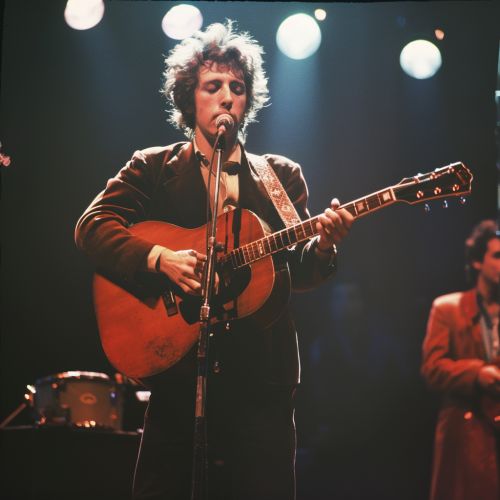Bob Dylan: Difference between revisions
(Created page with "== Early Life and Career == Bob Dylan, born Robert Allen Zimmerman on May 24, 1941, in Duluth, Minnesota, is an American singer-songwriter, author, and visual artist. He grew up in Hibbing, Minnesota, where he developed an early interest in music, particularly the blues and folk music. Dylan's early influences included Woody Guthrie, Robert Johnson, and Hank Williams, whose styles and themes would later permeate his own work. Dylan moved to New York...") |
No edit summary |
||
| Line 15: | Line 15: | ||
In 1965, Dylan made a controversial shift from acoustic folk to electric rock music, a move that was met with mixed reactions from his fanbase. This period saw the release of "Bringing It All Back Home," "Highway 61 Revisited," and "Blonde on Blonde," albums that are now considered some of the greatest in rock history. The song "Like a Rolling Stone," from "Highway 61 Revisited," is particularly notable for its innovative use of electric instruments and its complex, introspective lyrics. | In 1965, Dylan made a controversial shift from acoustic folk to electric rock music, a move that was met with mixed reactions from his fanbase. This period saw the release of "Bringing It All Back Home," "Highway 61 Revisited," and "Blonde on Blonde," albums that are now considered some of the greatest in rock history. The song "Like a Rolling Stone," from "Highway 61 Revisited," is particularly notable for its innovative use of electric instruments and its complex, introspective lyrics. | ||
[[Image:Detail-91653.jpg|thumb|center|Bob Dylan performing on stage with a guitar and harmonica.|class=only_on_mobile]] | |||
[[Image:Detail-91654.jpg|thumb|center|Bob Dylan performing on stage with a guitar and harmonica.|class=only_on_desktop]] | |||
== Lyrical Themes and Style == | == Lyrical Themes and Style == | ||
Latest revision as of 06:41, 20 June 2024
Early Life and Career
Bob Dylan, born Robert Allen Zimmerman on May 24, 1941, in Duluth, Minnesota, is an American singer-songwriter, author, and visual artist. He grew up in Hibbing, Minnesota, where he developed an early interest in music, particularly the blues and folk music. Dylan's early influences included Woody Guthrie, Robert Johnson, and Hank Williams, whose styles and themes would later permeate his own work.
Dylan moved to New York City in 1961, where he became involved in the burgeoning folk music scene in Greenwich Village. His performances at local clubs and coffeehouses quickly garnered attention, leading to a recording contract with Columbia Records in 1962. His self-titled debut album, released in March 1962, consisted mainly of traditional folk, blues, and gospel material, but it was his second album, "The Freewheelin' Bob Dylan" (1963), that established him as a significant voice in music.
Musical Evolution
Folk and Protest Songs
Dylan's early work is characterized by its protest songs, which addressed social and political issues of the time. Songs like "Blowin' in the Wind" and "The Times They Are a-Changin'" became anthems of the civil rights movement and the anti-war movement. His lyrics, often infused with poetic and literary elements, distinguished him from his contemporaries and earned him the title of "voice of a generation."
Electric Transition
In 1965, Dylan made a controversial shift from acoustic folk to electric rock music, a move that was met with mixed reactions from his fanbase. This period saw the release of "Bringing It All Back Home," "Highway 61 Revisited," and "Blonde on Blonde," albums that are now considered some of the greatest in rock history. The song "Like a Rolling Stone," from "Highway 61 Revisited," is particularly notable for its innovative use of electric instruments and its complex, introspective lyrics.


Lyrical Themes and Style
Dylan's lyrics have been the subject of extensive analysis and interpretation. His work often incorporates a wide range of themes, including love, politics, religion, and philosophy. His use of symbolism, metaphor, and allegory has made his songs rich in meaning and open to various interpretations.
Influence of Literature
Dylan's songwriting is heavily influenced by literature. He has cited the works of Arthur Rimbaud, William Blake, and John Steinbeck as significant influences. His lyrics often reflect the stream of consciousness technique found in modernist literature, and his narrative style has been compared to that of Homer and Shakespeare.
Religious and Spiritual Themes
Throughout his career, Dylan has explored religious and spiritual themes in his music. His 1979 album "Slow Train Coming" marked a period of Christian conversion, during which he released several gospel-influenced albums. Songs like "Gotta Serve Somebody" and "Every Grain of Sand" reflect his deep engagement with Christian theology.
Cultural Impact and Legacy
Bob Dylan's impact on music and culture is profound. He has been a major influence on countless artists across various genres, including The Beatles, Jimi Hendrix, and Bruce Springsteen. His ability to blend different musical styles and his innovative approach to songwriting have left an indelible mark on the music industry.
Awards and Honors
Dylan has received numerous awards and honors throughout his career, including the Nobel Prize in Literature in 2016, which recognized his contributions to the literary world through his songwriting. He has also been inducted into the Rock and Roll Hall of Fame, the Songwriters Hall of Fame, and has received the Presidential Medal of Freedom.
Influence on Popular Culture
Dylan's influence extends beyond music into popular culture. His songs have been featured in numerous films, television shows, and commercials. His distinctive voice and enigmatic persona have made him a cultural icon, and his work continues to inspire new generations of artists and fans.
Discography and Notable Works
Dylan's extensive discography includes over 39 studio albums, numerous live albums, and countless compilations. Some of his most notable works include:
- "The Freewheelin' Bob Dylan" (1963)
- "Bringing It All Back Home" (1965)
- "Highway 61 Revisited" (1965)
- "Blonde on Blonde" (1966)
- "Blood on the Tracks" (1975)
- "Desire" (1976)
- "Time Out of Mind" (1997)
- "Modern Times" (2006)
Each of these albums showcases Dylan's evolving musical style and his ability to address a wide range of themes and subjects.
